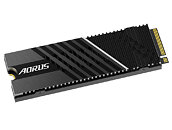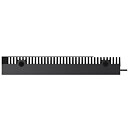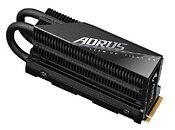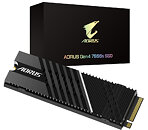Monday, January 18th 2021

GIGABYTE Launches the AORUS Gen4 7000s M.2 NVMe SSD
Gigabyte Technology, one of the top global manufacturers of motherboards, graphics cards, and hardware solutions, announces today the latest AORUS Gen4 7000s SSD with up to 7 GB/s read speed. Enhanced by the new generation PCIe 4.0 controller with advanced 3D-TLC NAND Flash, it boosts up to 55% more performance than previous generation PCIe 4.0 NVMe SSD. AORUS Gen4 7000s SSDs come in two capacity variants, 2 TB and 1 TB with M.2 2280 interface to make installation easy. They equip big aluminium thermal interface in different sizes and double side thermal pad with Nanocarbon coating for improved heat dissipation. Meanwhile, the SSD Tool Box application provides the instant overview and adjustment of SSD status.
"The storage devices are taking advantage of the PCIe 4.0 transfer speed that raised from 5 GB/s to almost 8 GB/s, which is great news for users who expect to optimize storage performance and reduce the bottle neck of system operation." said Jackson Hsu, Director of the GIGABYTE Channel Solutions Product Development Division. "AORUS Gen4 7000s SSDs further advance the standards set by our previous SSD products to provide users with breakthrough performance. After the OS installed, uses can enjoy unprecedented 7 GB/s read speed with 1 TB or 2 TB storage capability. The thermal solution and the double-sided thermal pad are designed to slow down the throttling that might occur at high-speed operation of SSD, thus boost the system performance."AORUS Gen4 7000s SSDs equip the latest Phison E18 selected 8-channel controller, which provides users with ultimate random access rate, as well as the high speed 3D-TLC NAND Flash and SLC cache design that brings the PCIe 4.0 into full play. Under the real test, AORUS Gen4 7000s SSD features read speed up to 7 GB/s and write speed up to 6.85 GB/s, which is 55% faster than PCIe 4.0 NVMe SSD, two times faster than PCIe 3.0 SSD, and up to 13 times faster than SATA SSD. Enhanced by Phison's E18 controller, AORUS Gen4 7000s SSD not only improves AI multitasking operation, but power up content creators, gamers, and users eager for extreme performance.
The high-speed SSD generates heat on full speed operation, and normally thermal throttling is implemented as a safety feature to prevent data loss, or wear-out the memory chips and controllers. The throttling state engages to maintain the stability and durability, however it slows down the performance and it reduces the transfer rate. In order to keep AORUS Gen4 7000s SSD cool while it is running at high speed, GIGABYTE employs the special-designed double-sided aluminium heatsink with Nanocarbon coating. By utilizing the clearance area smartly between slots on motherboards, the size of the thermal fins can be maximized to enlarge the surface area of dissipation. This design can support different M.2 slots perfectly on various motherboards to avoid possible interference by VGA cards installed above the M.2 SSD. AORUS Gen4 7000s SSD also equip high conductivity thermal pad to improve heat dissipation 30% better than metal thermal pad.
For those progressive M.2 users who prefer more extreme thermal solution without installing SSDs between PCIe expansion slots, AORUS Gen4 7000s SSD comes in another version of heatsink with integrated heatpipes. With the same double-sided heat spreader with Nanocabon coating and high conductivity pad design, but optimized on the height and dissipation area, AORUS Gen4 7000s SSD promises the consistent cooling and high performance for those water cooling users to avoid throttling from the overheating caused by no air flow assistance of the CPU fan. Users can customize their thermal allocation according to personal needs by GIGABYTE's thoughtful design, which balances between the high performance and low temperature.
AORUS Gen4 7000s SSD features PCIe 4.0 NVMe M.2 interface design. To release the breakthrough performance of read speed up to 7 GB/s, AMD X570 / B550 motherboards or Intel Z490 motherboards with next-gen Intel Core processors supported are highly-recommended. With GIGABYTE R&D's professional adjustment, comprehensive verification, software enhancement, and the 5 years warranty service, GIGABYTE motherboards offers more stability with higher performance, which is definitely the best choice for users.
For more information, visit the product page.
"The storage devices are taking advantage of the PCIe 4.0 transfer speed that raised from 5 GB/s to almost 8 GB/s, which is great news for users who expect to optimize storage performance and reduce the bottle neck of system operation." said Jackson Hsu, Director of the GIGABYTE Channel Solutions Product Development Division. "AORUS Gen4 7000s SSDs further advance the standards set by our previous SSD products to provide users with breakthrough performance. After the OS installed, uses can enjoy unprecedented 7 GB/s read speed with 1 TB or 2 TB storage capability. The thermal solution and the double-sided thermal pad are designed to slow down the throttling that might occur at high-speed operation of SSD, thus boost the system performance."AORUS Gen4 7000s SSDs equip the latest Phison E18 selected 8-channel controller, which provides users with ultimate random access rate, as well as the high speed 3D-TLC NAND Flash and SLC cache design that brings the PCIe 4.0 into full play. Under the real test, AORUS Gen4 7000s SSD features read speed up to 7 GB/s and write speed up to 6.85 GB/s, which is 55% faster than PCIe 4.0 NVMe SSD, two times faster than PCIe 3.0 SSD, and up to 13 times faster than SATA SSD. Enhanced by Phison's E18 controller, AORUS Gen4 7000s SSD not only improves AI multitasking operation, but power up content creators, gamers, and users eager for extreme performance.
The high-speed SSD generates heat on full speed operation, and normally thermal throttling is implemented as a safety feature to prevent data loss, or wear-out the memory chips and controllers. The throttling state engages to maintain the stability and durability, however it slows down the performance and it reduces the transfer rate. In order to keep AORUS Gen4 7000s SSD cool while it is running at high speed, GIGABYTE employs the special-designed double-sided aluminium heatsink with Nanocarbon coating. By utilizing the clearance area smartly between slots on motherboards, the size of the thermal fins can be maximized to enlarge the surface area of dissipation. This design can support different M.2 slots perfectly on various motherboards to avoid possible interference by VGA cards installed above the M.2 SSD. AORUS Gen4 7000s SSD also equip high conductivity thermal pad to improve heat dissipation 30% better than metal thermal pad.
For those progressive M.2 users who prefer more extreme thermal solution without installing SSDs between PCIe expansion slots, AORUS Gen4 7000s SSD comes in another version of heatsink with integrated heatpipes. With the same double-sided heat spreader with Nanocabon coating and high conductivity pad design, but optimized on the height and dissipation area, AORUS Gen4 7000s SSD promises the consistent cooling and high performance for those water cooling users to avoid throttling from the overheating caused by no air flow assistance of the CPU fan. Users can customize their thermal allocation according to personal needs by GIGABYTE's thoughtful design, which balances between the high performance and low temperature.
AORUS Gen4 7000s SSD features PCIe 4.0 NVMe M.2 interface design. To release the breakthrough performance of read speed up to 7 GB/s, AMD X570 / B550 motherboards or Intel Z490 motherboards with next-gen Intel Core processors supported are highly-recommended. With GIGABYTE R&D's professional adjustment, comprehensive verification, software enhancement, and the 5 years warranty service, GIGABYTE motherboards offers more stability with higher performance, which is definitely the best choice for users.
For more information, visit the product page.





37 Comments on GIGABYTE Launches the AORUS Gen4 7000s M.2 NVMe SSD
There's also the technical issue of performance: soldered-down solutions (unless the motherboard maker wants to take on the cost of developing a bespoke integrated SSD, which definitely isn't cheap) are typically low performance due to either being a single package, or having few DRAM channels and dice, lowering parallelism. This affects both random and sequential performance, so it's a surefire way to make your SSD perceptibly slower, not just measurably.
For the DIY market, this would make no sense whatsoever. For prebuilt desktops, it doesn't really either, as soldered components increase service costs and points of failure (it's cheaper to replace an SSD or a motherboard under warranty than both!). For laptops it's not quite uncommon, though it only really applies to very thin-and-light designs as for anything else the above risk factors and cost increases don't make sense. (Also there isn't much volume/area to be saved using a soldered-down SSD vs. something like an m.2 2242.) Of course there's also Apple, who like to lock their customers in and hate third-party upgrades, and charge enough of a premium for everything to not really care about things like that. They also have the mindshare (and to some extent the type of customer base) to allow them not to care about this.
This is much the same as why nobody would risk launching a motherboard with soldered-down RAM outside of very specialized markets. It just doesn't make sense economically, practically, or for the user.
And yeah, it'd be something OEM's would do, just like they do w/ soldered RAM. If there weren't advantages for them, they wouldn't do that either.
As for soldered RAM: again, they only do that in places where it has distinct advantages, in particular space savings. RAM is also far easier to implement than an SSD - it's essentially just traces, chips and power delivery. No controllers, no firmware, no controller-to-NAND interfaces, etc. If soldered RAM was advantageous beyond that you'd see it in pre-built desktops everywhere.
I picture someone like a Wal*Mart or a government/school systems buying 1000's and 1000's of these:
www.dell.com/en-us/work/shop/desktops-all-in-one-pcs/optiplex-3080-micro/spd/optiplex-3080-micro/s010o3080mffus
I'm not arguing that enthusiast mainboards come with soldered on SSD's, I'm just saying I think there's something there to be had with the economics, speed, latency, etc.
Why did Sony hardwire the PS5 SSD?
As for RAM: can you show me a single system that isn't extremely space-constrained (i.e. wouldn't fit SODIMMs without compromising on something crucial, like battery or cooling) that has soldered-on RAM? And again: soldering on RAM to a motherboard is much simpler than creating a fully integrated on-PCB SSD. There are BGA single-package SSDs that are used in some tablets and really tiny PCs. But those are also quite low performance. Beyond that, RAM is much easier to add directly to a PCB than an SSD would be. An OEM could no doubt just buy a reference PCB design from, say, Phison and integrate it into their motherboard designs, but that's still far more complex than just wiring up an m.2 port, and it requires PCB space that is often not available on current cramped motherboards.
As for integrating OS storage on-die in a CPU - sure, that would be amazing in terms of latency, but it would massively increase die sizes, and thus balloon CPU costs. You'd also still need a heap of NAND in there to achieve decent parallelism and thus overall performance - a single die, even coupled directly to the CPU with near zero latency, would be terribly slow. NAND is also generally produced on different nodes than logic, and require different optimizations and production techniques. A monolithic die containing both a lot of high-performance logic and a decent amount of NAND (128GB or more) would be immensely complex to manufacture, yields would likely be terrible, there's a high chance the CPU/GPU would perform worse than if it was made on a bespoke logic-only process.
An MCM solution would be better and easier, but leaves the question of fitting it within a reasonable package size - for example, no current BGA SSD could fit in the space used by one CCX in a Zen 2/3 CPU, though of course an unpackaged version would be smaller - and if there aren't more valuable things that could be added in for the same cost, such as more cache. With upcoming 3D stacking tech it's likely we'll see MCM CPUs with active interposer layers consisting of lots of cache, and they could feasibly also add NAND there, though there is still the question of whether this would be worth the cost (interposers are typically made on cheap, old nodes (45-65nm), while current NAND is made on flash-optimized 10-12nm nodes). There's also the question of whether a NAND-optimized node is suited for the things needed in an active interposer such as TSVs. And there's still the fact that an SSD (unlike RAM) needs multiple types of components (well, RAM needs RAM + power circuitry): the controller, NAND, DRAM (if you want good performance) and power circuitry. That means it isn't as simple as just sticking a few more chips onto your PCB or package. For CPU integrations the same is somewhat true for RAM due to density/capacity (you wouldn't be able to fit the 8 DRAM chips found on most DIMMs into a CPU package either), but there you have other solutions like HBM which stacks these on top of each other for higher density. No such solution exists for flash, and it would likely be prohibitively expensive if someone were to make it.
So again, there's very little reason for integrating SSDs onto motherboards (or into CPUs), and for the few extremely space constrained cases where it does matter, most OEMs are happy to accept the compromises of current BGA offerings. But there's no reason even low-end motherboards would integrate this - at a significant added cost - rather than just stick an m.2 socket on there and either leave it to the builder to fill, or if they are the system builder, stick whatever SSD they want for the relevant system configuration in there.